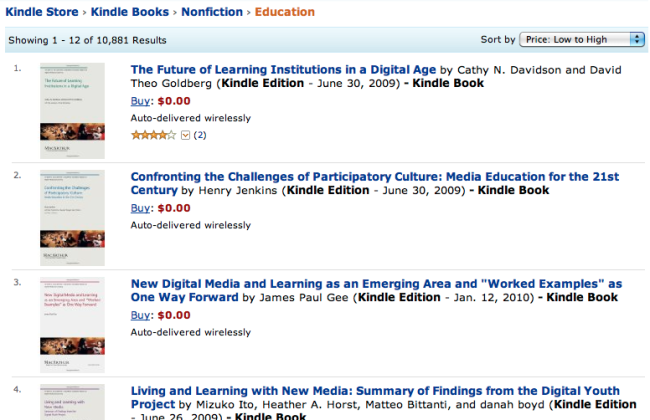Academic reading on the Amazon Kindle
I decided last week to sell my Sony Reader PRS-600 Touch and replace it with an Amazon Kindle. Why would I do that? After all, you can do things with the Sony that you can’t with the Kindle: ‘reflow’ PDFs, write notes using a stylus, add extra memory with the minimum of fuss? I’ll perhaps compare and contrast the Sony Reader and the Kindle in more depth another time, but suffice to say that the things that the Kindle can do – namely wirelessly sync, have access to other people’s annotations, and make notes using a keyboard – slightly edge out the Sony Reader for me.
But that’s not the point of this post.
The thing that I didn’t realise until I got the Kindle is the sheer range of educational and academic books instantly available via the Kindle Store:
Sorting by Price: Low to High yields some absolute gems that, granted, are available for free as PDFs, but are formatted perfectly for the Kindle. It makes for a wonderful experience:
Not only can you access Kindle books on the Kindle device itself, but via the iPhone/iPad/PC/Mac, etc. And, just as you can continue where you left off with films you watch on any iTunes-connected device, so with the Kindle, you can continue where you left off with a book. Useful!
The other thing, really handy for academic articles, is that it shows you (very faintly) the popular passages that other people have highlighted. It means you don’t miss the important stuff!
Although the ‘current economic climate’ (a phrase I’m increasingly tired of hearing) means that it’s unlikely to happen this year, I can see organizations in the near future ensuring that they publish not only to PDF but to ePub (for the upcoming Google Editions store) and Kindle format. Just as app makers target primarily the iPhone and Android markets so I can see organizations pushing things out to PDF, ePub and Kindle formats. It’s not hard with free tools such as Calibre!
Image CC BY-NC-SA brianjmatis

![I guess it makes sense for a robot to read an e-book [401]](https://dougbelshaw.com/blog/wp-content/uploads/2010/07/kindle_wall-e.jpg)


Did you see this article from the Seattle Times?
http://seattletimes.nwsource.com/html/businesstechnology/2011938870_kindle24.html
My thoughts on that article
http://elearningstuff.wordpress.com/2010/05/27/%e2%80%9ci-don%e2%80%99t-like-the-kindle%e2%80%9d/
James Clay
Well, indeed. But then, that cites students who are *used* to physical
textbooks and are using things that have been *adapted* for use on the
Kindle. As with the iPad, things made specifically for a device are always
going to be more compelling!
I do agree and as I say in many of my presentations on this subject (but realise I don’t think I have written about) is that publishers do need to rethink the way they *sell* content on these platforms.
As iTunes has allowed individual tracks from Albums to be purchased, publishers should start to see the potential income stream and flexibility that selling individual chapters or sections of academic text books could bring. Learners wouldn’t need to buy the whole book, they could buy a single or a couple of chapters as and when they need them.
James
Agreed! 🙂
Meh: http://friendfeed.com/ajc/1afff048/last-ebook
Fair enough points by you, D’Arcy and Stephen. But you’re all older than me.
Perhaps it’s a generational thing? 😉
You may have a point, but for me it’s primarily a price thing. But then, I don’t have an iPhone either ;-0